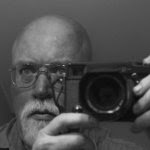First Look: Zeiss Ikon 50/1.5 Sonnar M lens
 Well, this is groundbreaking. Not the 50/1.5 Zeiss Sonnar lens. Zeiss had 50/1.5 lenses before I was born. I’m referring to the fact that I’m giving it a “First Look” review ahead of just about everyone else. A while back, Zeiss Ikon decided to close down their gray market outlets in the
Well, this is groundbreaking. Not the 50/1.5 Zeiss Sonnar lens. Zeiss had 50/1.5 lenses before I was born. I’m referring to the fact that I’m giving it a “First Look” review ahead of just about everyone else. A while back, Zeiss Ikon decided to close down their gray market outlets in the I assume that, like the previous Zeiss Ikon lenses in the M mount, this lens was designed by Carl Zeiss in  calipers under the plethora of junk on my desk. I’m glad this is a first look at the lens. Let’s just say that it is very close in size to the Leica 50/2 Summicron, only shorter. Both lenses are about 17.5mm in circumference at their widest point, and the Sonnar is a few mm shorter. In practice, I know of very few photographers who use cases, so lens length differences here are moot. Of course, the front element on the Zeiss lens is much larger. There is no pull-out hood on the Zeiss, so the vented bayonet mount lens hood is recommended. Like the recent Zeiss and Voigtländer lenses, this hood can stay in place while removing and replacing the lens cap. Unlike the most recent Summicron, there is a protuberance on the bottom of the focusing ring. In practice, I’m not sure I could accurately tell if I were using the 50/2 Summicron, 50/1.5 Sonnar, or the 50/1.5 pre-asph Summilux based on size alone. The fit and finish of the new Sonnar are first rate, very similar to the Leica lenses but perhaps with slightly sharper edges.
calipers under the plethora of junk on my desk. I’m glad this is a first look at the lens. Let’s just say that it is very close in size to the Leica 50/2 Summicron, only shorter. Both lenses are about 17.5mm in circumference at their widest point, and the Sonnar is a few mm shorter. In practice, I know of very few photographers who use cases, so lens length differences here are moot. Of course, the front element on the Zeiss lens is much larger. There is no pull-out hood on the Zeiss, so the vented bayonet mount lens hood is recommended. Like the recent Zeiss and Voigtländer lenses, this hood can stay in place while removing and replacing the lens cap. Unlike the most recent Summicron, there is a protuberance on the bottom of the focusing ring. In practice, I’m not sure I could accurately tell if I were using the 50/2 Summicron, 50/1.5 Sonnar, or the 50/1.5 pre-asph Summilux based on size alone. The fit and finish of the new Sonnar are first rate, very similar to the Leica lenses but perhaps with slightly sharper edges.
The aperture ring has a half-click stop between f/1.5 and f/2, and 1/3 click stops from f/2 to f/16.
My first roll of film using this lens was TRI-X shot at the nominal ISO and developed in Harvey's Panthermic 777 developer. This is not a fine grain film, so conclusions regarding the lens' resolution wide open are not very conclusive. To me, the resolution seems adequate and the contrast very good, not surprising for Zeiss glass. But in a fast lens, bokeh becomes a big issue for me. Some fast lenses such as theVoigtländer 50/1.5 Nokton have bokeh that some photographers do not like. The bokeh of the Sonnar 50/1.5 seems very pleasing to me, at least in the initial shots I have viewed.
The edges of out of focus objects are smooth, and hard sources of bright light do not produce discoid platters with hard edges. Very nice.
I will try to get some additional shots this week using slower film with greater resolution. For now, I could not be happier with this lens, particularly at 1/3 the price of the comparable Leica 50/1.4 Summilux.


<< Home